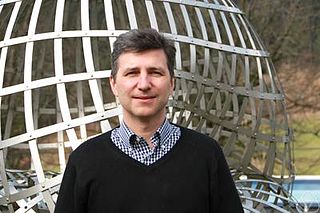In group theory, a branch of abstract algebra, the Whitehead problem is the following question:
Is every abelian group A with Ext1(A, Z) = 0 a free abelian group?

Saharon Shelah is an Israeli mathematician. He is a professor of mathematics at the Hebrew University of Jerusalem and Rutgers University in New Jersey.
In mathematics, and particularly in axiomatic set theory, the diamond principle◊ is a combinatorial principle introduced by Ronald Jensen in Jensen (1972) that holds in the constructible universe and that implies the continuum hypothesis. Jensen extracted the diamond principle from his proof that the axiom of constructibility implies the existence of a Suslin tree.

Matthew Dean Foreman is an American mathematician at University of California, Irvine. He has made notable contributions in set theory and in ergodic theory.
In model theory, a branch of mathematical logic, the spectrum of a theory is given by the number of isomorphism classes of models in various cardinalities. More precisely, for any complete theory T in a language we write I(T, κ) for the number of models of T (up to isomorphism) of cardinality κ. The spectrum problem is to describe the possible behaviors of I(T, κ) as a function of κ. It has been almost completely solved for the case of a countable theory T.
Set theory of the real line is an area of mathematics concerned with the application of set theory to aspects of the real numbers.
In set theory, Cichoń's diagram or Cichon's diagram is a table of 10 infinite cardinal numbers related to the set theory of the reals displaying the provable relations between these cardinal characteristics of the continuum. All these cardinals are greater than or equal to , the smallest uncountable cardinal, and they are bounded above by , the cardinality of the continuum. Four cardinals describe properties of the ideal of sets of measure zero; four more describe the corresponding properties of the ideal of meager sets.
In set theory, a branch of mathematical logic, Martin's maximum, introduced by Foreman, Magidor & Shelah (1988) and named after Donald Martin, is a generalization of the proper forcing axiom, itself a generalization of Martin's axiom. It represents the broadest class of forcings for which a forcing axiom is consistent.

Menachem Magidor is an Israeli mathematician who specializes in mathematical logic, in particular set theory. He served as president of the Hebrew University of Jerusalem, was president of the Association for Symbolic Logic from 1996 to 1998 and as president of the Division for Logic, Methodology and Philosophy of Science and Technology of the International Union for History and Philosophy of Science (DLMPST/IUHPS) from 2016 to 2019. In 2016 he was elected an honorary foreign member of the American Academy of Arts and Sciences. In 2018 he received the Solomon Bublick Award.

Tomek Bartoszyński is a Polish-American mathematician who works in set theory.
In the mathematical field of set theory, the Solovay model is a model constructed by Robert M. Solovay (1970) in which all of the axioms of Zermelo–Fraenkel set theory (ZF) hold, exclusive of the axiom of choice, but in which all sets of real numbers are Lebesgue measurable. The construction relies on the existence of an inaccessible cardinal.
In the mathematical discipline of set theory, a cardinal characteristic of the continuum is an infinite cardinal number that may consistently lie strictly between , and the cardinality of the continuum, that is, the cardinality of the set of all real numbers. The latter cardinal is denoted or . A variety of such cardinal characteristics arise naturally, and much work has been done in determining what relations between them are provable, and constructing models of set theory for various consistent configurations of them.
Micha Asher Perles is an Israeli mathematician working in geometry, a professor emeritus at the Hebrew University. He earned his Ph.D. in 1964 from the Hebrew University, under the supervision of Branko Grünbaum. His contributions include:
In mathematics, iterated forcing is a method for constructing models of set theory by repeating Cohen's forcing method a transfinite number of times. Iterated forcing was introduced by Solovay and Tennenbaum (1971) in their construction of a model of set theory with no Suslin tree. They also showed that iterated forcing can construct models where Martin's axiom holds and the continuum is any given regular cardinal.
In mathematical set theory, the Sacks property holds between two models of Zermelo–Fraenkel set theory if they are not "too dissimilar" in the following sense.
In mathematics, Wetzel's problem concerns bounds on the cardinality of a set of analytic functions that, for each of their arguments, take on few distinct values. It is named after John Wetzel, a mathematician at the University of Illinois at Urbana–Champaign.
Maryanthe Elizabeth Malliaris is a professor of mathematics at the University of Chicago, a specialist in model theory.

Michael Drmota is an Austrian mathematician and professor at TU Wien.

Robert Franz Tichy is an Austrian mathematician and professor at Graz University of Technology.






